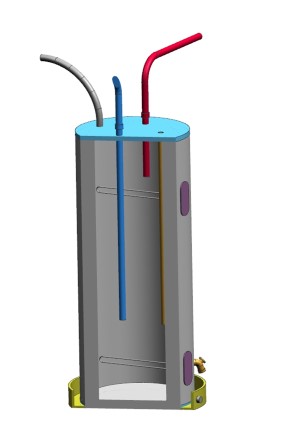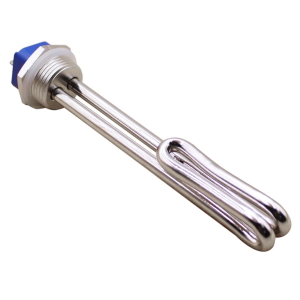Low Watt Incoloy Easy to Install Heating Element
Electric Heating Elements
Troubleshooting & Replacing Guide
How to replace electric heating elements on the water heater. See what the most common causes of the water heater element failure are, testing and repair tips. How to choose the right electric heating element and what to consider when buying for a long and reliable water heating in residential applications.
What are heating elements?
 Electric water heater
Electric water heater
Heating elements are essential parts of the electric water heaters designed to transform electrical energy into heat – therefore heating the water. Most of the time, they are made of copper, stainless steel, titanium, and Incoloy.
How to choose a heating element
Every electric water heater is equipped with one or two heating elements, but it depends on the size of the unit.
Consider the following factors when choosing the correct heating element for replacement.
- Element flange style
- Voltage and wattage
- Watt-density
Types of heating elements
In both older and newer water heaters, there are two different types of electric heating elements providing various attachments to the heater's body:
- Flange-type (universal flange, flat flange, round head)
- Screw-in type

Most electric water heaters have two heating elements, upper and lower, where the screw-in type is the most common type, as it is easy to install, remove, and service. Models with a smaller capacity, including point-of-use models, have only one heating element. The water heater element with the flange (bolt-in type) is another type but is used less.
Both types are immersion-type elements, with the U-shape design, heating water when energized and providing energy efficiency close to 100%.
Manufacturers will use various types, different in voltages and watt densities, where 240 volts and 4500 watts are the most common. You can check the voltage and wattage on the rating plate of the water heater.
What's the purpose of thermostats?
Each element has a designated thermostat to adjust the temperature, usually between 120 F and 140 F. The thermostat setting allows a heating element to provide more or less power or lower and higher temperature of the outgoing water. If the thermostat becomes damaged or stops working, water becomes too hot, or there won't be any hot water.
The upper thermostat is the main one as it controls the heat generated by both elements. It comes with the High Limit Switch reset button, and it shuts down the heater if the temperature becomes too high.
When selecting the best electric water heater for your home, you will have an option to buy a unit with low or high-watt density elements.
A low-watt density heating element is what you should look for, as it provides an even distribution of heat and lasts longer. Even better is the ultra-low watt-density, a premium-grade element that can reduce the limescale buildup and dry-firing.
How to diagnose a water heater element problem?
Note: Professional installation and repair are recommended. Find local plumbers and get FREE Quotes!
To check if there is a problem with the heating element(s), turn on the hot water tap.
If hot water is running for a short time before it gets cold, the problem is with the bottom heating element. Even if the upper one is still working, it will heat water only at the top of the tank but will eventually run out fast.
If water is always cold at the fixture, it looks like both elements are gone and have to be replaced.
What can cause heating elements to fail?
Heating elements can break over time because they will turn on and off quite often, keeping the water at the set temperature, either using hot water or not.
Note: Keep in mind that the electric heating elements with the higher wattage require more Amps and heavier gauge wire.
Below are the most common reasons for the heating element failure, so before troubleshooting, it is always a good idea to check and make sure that the circuit breaker is on and not tripped. Also, when pressing the reset button located right above the thermostat, you could fix the problem.
Sediment build-up
If you live in an area with hard water conditions, you probably had problems with the mineral deposits and limescale. The sediment build-up on the water heating elements will prevent heat transfer to the water at the proper rate, thus overheating and causing the element burnout.
The solution to this problem is to regularly clean the electric water heater element by brushing away the scale buildup. When selecting a new water heater, there is an option to buy a unit with the Incoloy type, which lasts longer and has better resistance to sediment buildup.
Another indication of the sediment buildup on the heating elements is the "sizzling" or "hissing" sound, which develops when water is trapped next to the element, which then boils water to steam.
Dryfire
Dryfire problem happens when the water heater elements while working are exposed to the air pockets. The part which is in contact with the air will get an excessive amount of heat. It takes several seconds for the copper heating element to burn out. They are designed to operate only when submerged in water.
Dryfiring can be recognized as the element shaft is annealed so soft that you can bend it with your fingers, and the plastic element is melted.
The recommendation is always to fill the electric water heater tank and bleed all the air from the system before turning on the power. The manufacturer's warranty does not cover the problem.
High voltage
If more than the design voltage is supplied to the heating element, the element will burn out. One example is the high voltage during the lighting or sometimes caused by the electric utility company. If there is less voltage provided, the heating element will work but will be less efficient.
Other problems that might affect the proper work are related to the vibration break, open circuit, or split sheath.
| Compare Quotes from Top-rated Water Heater Experts! Free, No-commitment Estimates. |
Compare Quotes from Top-rated Experts!
Free, No-commitment Estimates.
Tools needed for testing and replacing
- Multimeter
- Screwdriver
- Large socket/wrench
- Garden hose
How to test a water heater element
- Turn the power OFF to the water heater on the electrical panel.
- Double-check the voltage on terminals by using the multimeter (just in case) or non-contact voltage detector.
- Remove an access panel, insulation, and plastic cover.
- Disconnect wires from the heating element.
- Set the multimeter to OHM settings.
- Put one test probe on the terminal and the other probe on the steel tank. If the OHM multimeter needle moves, the element is grounded and needs to be replaced. Make sure to test both screws of the component.
You can also put one probe on one terminal and with the other probe touch the other terminal, and if the OHM multimeter needle doesn't move (no reading), the element is bad and should be replaced.
One of the indications that the element is grounded is if the water is boiling and the heater constantly trips the circuit breaker.
Continuity through the heating element indicates the current flow and heating. If there is no continuity, the electric circuit is open, so the electric current cannot flow.
If the element is functional, the reading should be between 10 and 16 ohms, depending on the wattage of the element.
How to replace an electric heating element
Note: If you don't feel comfortable with the repair, always contact the professional plumber.
Before you start replacing the broken electric water heater element on the water heater, make sure to use the same type with the same wattage and voltage. Check the element terminal block for the proper rating.
Note: Check if the breaker has tripped or if the fuse is blown in the fuse box.
A large socket wrench is needed to properly remove and install a screw-in type heating element, which is the most used type.
- Turn the water heater OFF on the electric service panel.
- Shut OFF the water supply and drain water below the broken element.
- Locate the broken electric heating element and make access by removing the insulation and cover.
- Ensure that the power is OFF by measuring the voltage on the thermostat terminals, which powers the element. The reading should show 0 volts.
- Disconnect the wires.
- Remove the electric element using the large socket with the hole or wrench. If it doesn't turn, use a longer leverage tool.
- Install a new rubber gasket and the heating element.
- Reconnect the wires and make sure they are snug and clean of debris and rust.
- Fill the tank up (make sure the drain valve is turned off and the garden hose removed).
- Open the hot water tap until all the air is out.
- Make sure there is no leak.
- Resume the power.
Heating elements are the most critical parts of the water heater – they are designed to heat water. Without it, there will be only cold water. While the price of the heating element is low, replacing the heating element is an easy job for handymen; it requires basic knowledge about plumbing and electricity. However, if you don't feel comfortable working on the heater, hire a professional.
Related
- Electric water heaters - buying guide
- Electric water heater installation
- Electric water heater troubleshooting
- Replacing a thermostat
- Home
- Electric Water Heaters
- Electric Heating Elements
Source: https://www.home-water-heater.com/electric-heating-elements.html
0 Response to "Low Watt Incoloy Easy to Install Heating Element"
Enviar um comentário